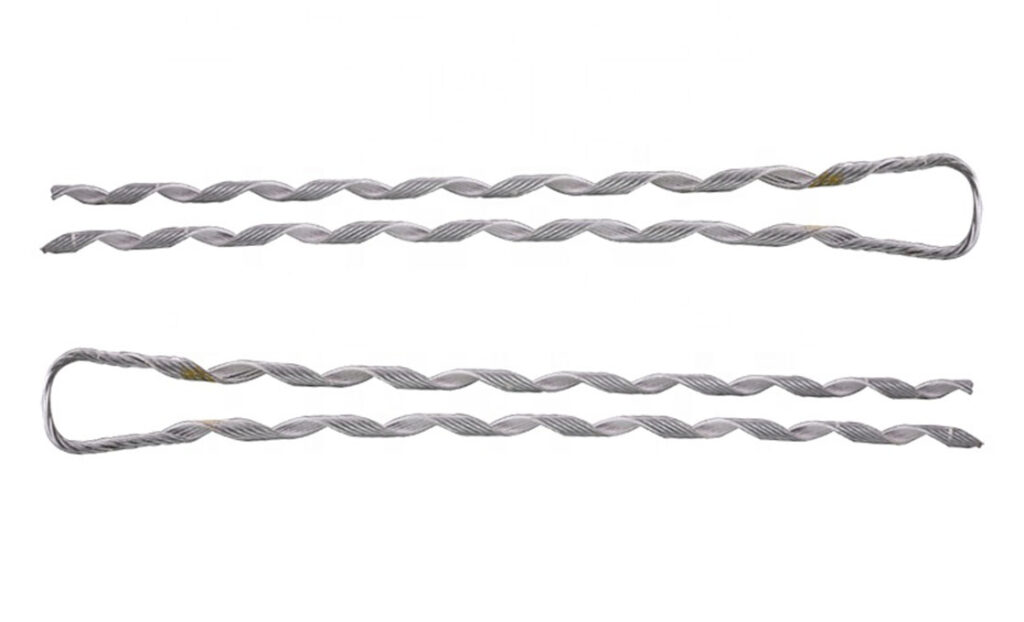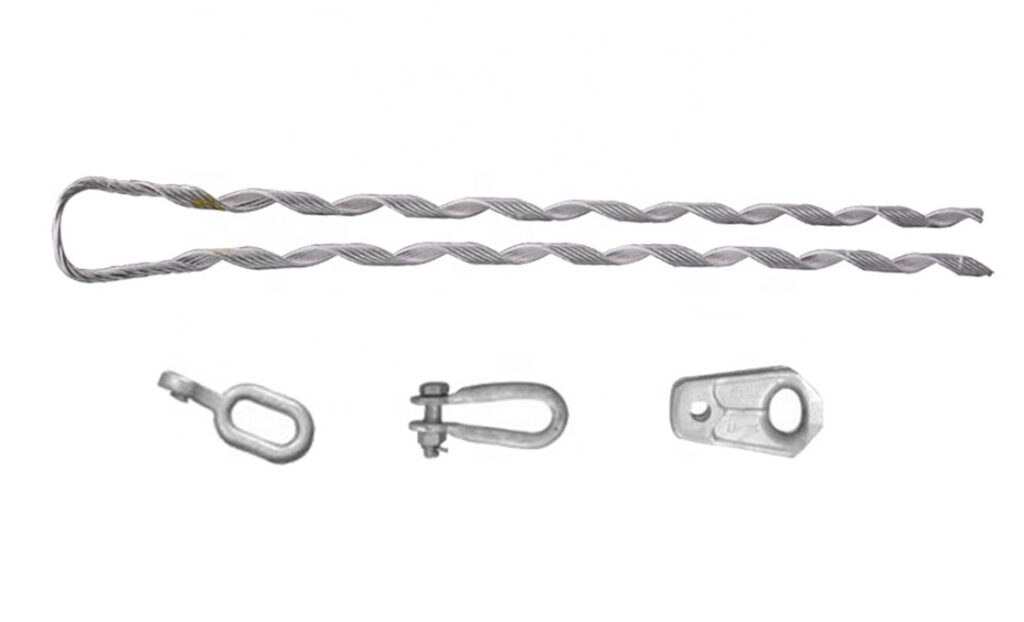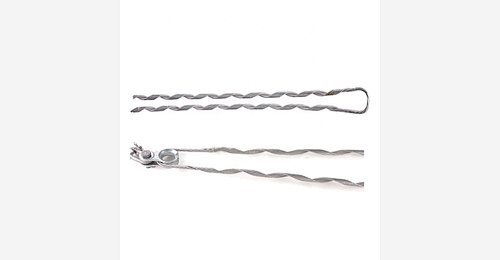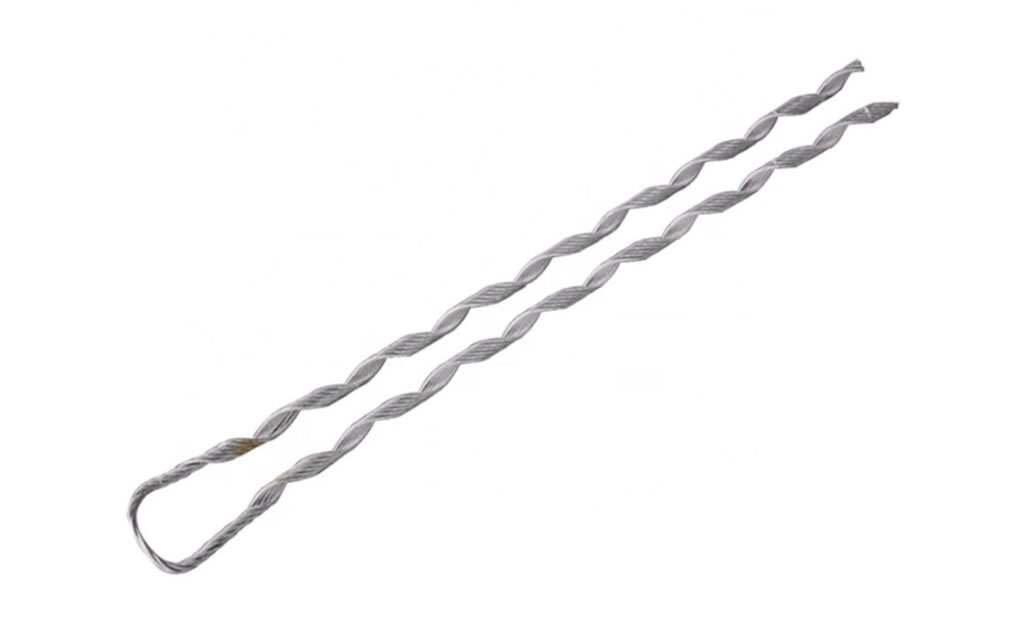
A preformed tension clamp is a type of clamp used to secure and support cables or conductors. It is also known as a dead-end grip or a preformed dead end. Its main function is to secure conductors, transfer tension and anchor points. The clamps have pre-formed shapes or helical shapes for easy installations. The design helps them to hold cables or conductors in place. It does this while allowing some degree of movement. This is to accommodate expansion and contraction to due temperature changes. Preformed tension clamps are from materials like stainless steel, galvanized steel or aluminum. They also allow ease of installation and have ability to maintain proper tension on the cables. Preformed tension clamps are reliable with ensures performance and longevity of the infrastructure. They find use in applications such as overhead transmission lines, distribution networks and telecommunications.
Parts of a preformed tension clamp
Preformed tension clamps have various parts that work together to offer the optimal performance to the clamp. The parts of the clamp vary depending on the specific design and application. They help to hold the cable or conductor in place while allowing for controlled movement. The following are the common parts and components of the preformed tension clamp.

- Body – this is the main component of the clamp that wraps around the cable or conductor. This is to provide support and tension to the application.
- Hardware – this includes bolts, nuts, washers and other fasteners used to secure the clamp onto a support structure.
- Tensioning device – some of the clamps have tensioning device or mechanism to adjust the tension applied to the cable.
- Insulation – these materials help to insulate the clamp from the support structure.
- Preformed wire – these are pre-shaped wires or strands integrated into the clamp body. They create a gripping mechanism to hold the cable or conductor in place.
- Armor rods – they provide extra protection to the cable from abrasion at the clamp attachment points.
- End fittings – these are optional components that ease the attachment of the clamp to the support structure.
Design features of the preformed tension clamp
The design features of the preformed tension clamps help ensure their effectiveness in securing cables. They also allow for controlled movement of the cables during expansion and contraction. The features contribute to the effectiveness, reliability and longevity of the clamps. The following are the design features of the preformed tension clamp.

- Preformed shape – the clamps have a specific shape that conforms to the contour of the cable they are to support. This design ensures a secure grp without causing damage to the cable.
- High strength materials – these clamps are from high-strength materials such as aluminum or stainless steel. The materials are able to withstand the mechanical stresses and environmental conditions.
- Inner surface – they may have textured surfaces to increase grip and prevent slippage. Some of the clamps include gripping mechanisms like wedges or teeth.
- End termination – this can be open-ended, closed loop or have attachment points like hooks or shackles. The design depends on the application and how the clamp connects to the other hardware.
- Adjustability – some of the clamps have adjustable components that allow for precise change of the clamping force.
- End fittings – the fittings integrate into the design of preformed tension clamps to ease installation.
- Gripping mechanism – the clamps have a gripping mechanism composed of preformed wires. The wires need strategic positioning to provide many points of contact with the cable. This helps to enhance the clamping force and stability.
- Corrosion resistance – the clamps are from resistant materials and have coatings to withstand stresses. This is to protect the clamp from environmental factors such as moisture, humidity and exposure to chemicals.
- Insulation – preformed tension clamps have insulation materials or coatings to prevent electrical contact between the clamp and conductors.
What is the importance of using preformed dead end
Use of preformed tension clamps offers several benefits in various applications. Preformed tension clamps help to support cables, prevent damage and ensure the reliability of electrical infrastructure. Additionally, it is important to select clamps that best suit your application needs. The following are the importance of using preformed tension clamps.

- Secure grip – the clamps provide a secure grip on cables preventing them from slipping or sagging. This helps maintain the integrity and reliability of electrical infrastructure.
- Tension maintenance – the clamps maintain a consistent level of tension on cables. This helps prevent excessive sagging which leads to power transmission inefficiencies.
- Ease of installation – the clamps are easier to install compared to traditional clamps.
- Reduced maintenance – the clamps need minimal maintenance due to their durable construction and reliable gripping mechanism. This helps reduce the ongoing maintenance costs and ensures long-term performance.
- Damage prevention – the design of the clamps ensures the cables stay in place without causing damage. The shape and gripping mechanism distribute the clamping force to reduce the risk of abrasion.
- Versatility – the clamps are versatile and can work in various applications. This is including overhead transmission lines, distribution networks and telecommunications.
- Durability – the clamps are from high strength materials such as aluminum or stainless steel. This makes them durable and resistant to factors such as corrosion, UV exposure and temperature variations.
Selecting the best preformed tension clamps
The selection process of the preformed tension clamps helps to ensure proper selection for your application. It also helps to choose the preformed tension clamp that best suits your performance for optimal performance. Additionally, it is advisable to consult with electrical engineers with experience in power line installations. They provide specific guidance based on the requirements and conditions of your power line project. The following are the factors to consider when choosing preformed tension clamps.

- Application and line design – consider the specific application and line design requirements. Determine whether the tension clamp will work in suspension points, dead ends, mid spans and other specific locations.
- Conductor type and size – different clamps have designs for specific conductor types and sizes. Consider this and ensure they are compatible with the conductor you are working with.
- Material and corrosion resistance – assess the materials to consider the corrosion resistance properties. This is especially when working in environments with harsh conditions.
- Tensioning and load capacity – check the tensioning and load capacity of the tension clamp. Consider the required tensioning type for the conductor. This helps to verify that the clamp matches or exceeds the expected loads and stresses experienced by the power line.
- Compliance with standards – consider the relevant industry standards, regulations and codes of using the preformed tension clamps. This is important for safety, reliability and compatibility with the power grid infrastructure.
- Manufacturer – checks on quality, reliability and customer support for each manufacturer. Consider the availability of technical documentation, installation guidelines and access to manufacturer support.
- Cost and budget – consider the cost effectiveness of the tension clamp to ensure quality, performance and durability. Compare prices and features from different manufacturers.
Cost considerations and comparisons for preformed dead end
Assessing the costs for preformed tension clamps involves considering several factors. These include the initial costs, installation costs and maintenance requirements. It is also important to compare preformed tension clamps with traditional clamps or other cable support methods. Additionally, it is advisable to conduct a cost-benefit analysis to help make an informed decision. The following are the factors to consider when checking costs for preformed tension clamps.

- Initial purchase price – the upfront costs of the clamps may be higher than the traditional clamps due to their specialized designs. Consider the benefits and performance advantages the clamps offer.
- Maintenance requirements – the clamps are durable and have gripping mechanisms which reduces the maintenance costs.
- Performance and reliability – the clamps offer superior performance and reliability compared to traditional clamps. They have a secure grip and ability to maintain tension for longer serviceable life.
- Industry standards and compliance – ensure the clamps meet relevant industry standards and specifications. This is to ensure compatibility and reliability. Adherence may add to the upfront costs and can help avoid potential issues and expenses.
- Installation costs – the clamps are easier and faster to install compared to traditional clamps. This can reduce installation costs, labor costs and lead to shorter project timelines.
- Lifecycle expenses – consider the lifecycle expenses associated with both performed tension clamps and alternative solutions.
- Customization and compatibility – the clamps have customization features to accommodate specific cable sizes. This ensures optimal performance and compatibility with the infrastructure.
Frequently asked questions
The clamps are devices used to secure and support cables in various applications such as overhead transmission lines. they work by wrapping around the cable or conductor and utilizing a preformed gripping mechanism to provide a secure hold.
Preformed tension clamps are grom high-strength materials such as aluminum or stainless steel. this offer durability and resistance to environmental factors like corrosion and temperature variations.
The clamps need minimal maintenance after installation due to their durable construction and reliable gripping mechanism. This also reduces the need for frequent inspections, adjustments and replacements.